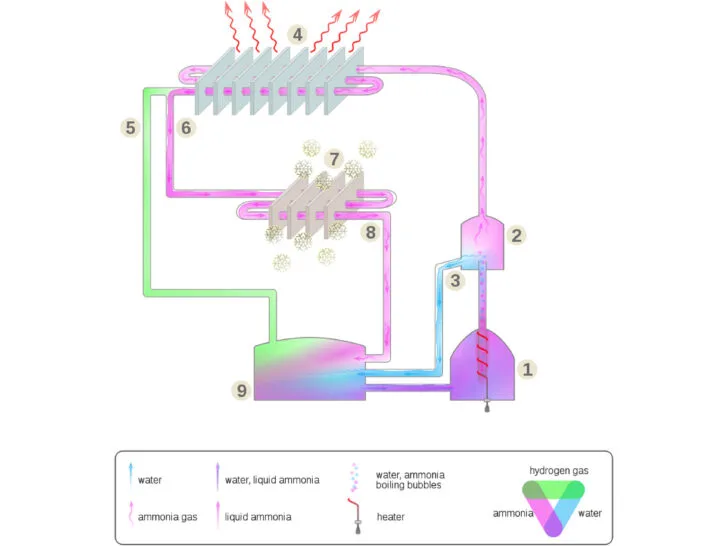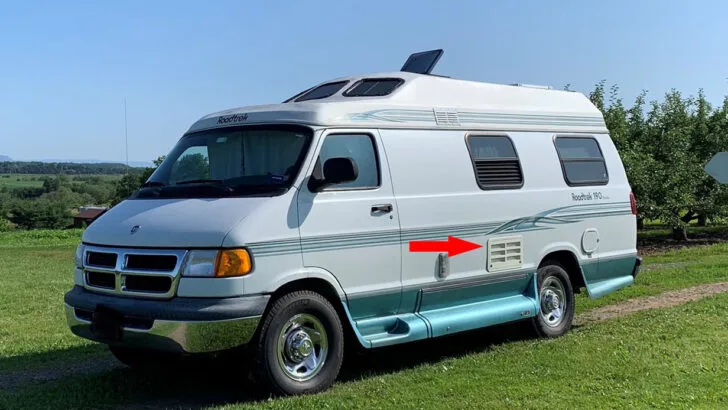What is a 3-way RV refrigerator, and how does it work? All 3 way RV refrigerators are what are known as absorption refrigerators. This is because they operate using the absorption cycle, where heat is needed to start the process.
But three different energy sources can be used to keep your food, beverages, and even medication safe and cool. In this post, we’ll sort out all the details.
- 1) What Is a 3-Way RV Refrigerator?
- 2) How Does an Absorption RV Fridge Work?
- 3) Does an RV Fridge Work Better on Gas or Electric?
- 4) What Are the Pros and Cons of a 3-Way RV Refrigerator?
- 5) Which 3-Way RV Refrigerator Is Best?
- 6) Free RVing Tips, Tricks, Reviews, Giveaways & More
What Is a 3-Way RV Refrigerator?
A 3-way RV refrigerator is a fridge that can be powered using any one of three different energy sources. Depending on where you’re camping or how you’re traveling, you can run a 3-way RV refrigerator on:
- propane (by burning it)
- 120V AC heating element (when on generator or shore power)
- 12V DC heating element (usually only an option when the vehicle’s engine is running)
How Does an Absorption RV Fridge Work?
If you’ve seen our post on absorption refrigerators, you know that a 3-way RV fridge actually uses heat to keep your food cold. This happens either via a propane burner flame or an electric heating element. It’s a completely closed system in which the refrigerant is constantly recycled, making it very efficient.
Regardless of the power source being used, an absorption system works in three stages: evaporation, absorption, and regeneration. During these stages, an ammonia-based liquid refrigerant uses water as the absorbent. This lowers the evaporation point of the ammonia to a temperature below that of the interior of the fridge, allowing the absorption cycle to cool.
The back of an RV absorption fridge has tubes, coils, and fins that look something like this:

In the back of an absorption fridge, you’ll see coils, fins, and wires.
Whether you’re running the fridge on 12V DC battery power as you drive, on generator or shore power at an RV power pedestal, or whether it’s running on gas (propane), the absorption system requires several steps to cool (this is true for both 3-way and 2-way fridges). The steps are as follows (the step numbers match the diagram just below):
- Heat is supplied to a liquid refrigerant (typically a mixture of ammonia & water), causing it to boil and turn into a gas.
- The now gaseous refrigerant travels through a separation chamber, where the water vapor condenses back to a liquid.
- The liquid water returns to the absorption chamber.
- The hot gaseous ammonia continues to rise through a condenser coil located near the top of the refrigerator, where the heat is extracted (to the outside air), causing the ammonia to condense back to a cold liquid form.
- Hydrogen gas (released as a byproduct of the condensing cycle) is separated and returned to the absorption chamber.
- The cooled, liquid ammonia now flows (due to gravity, part of why it’s important for an absorption refrigerator to be relatively level) down to an evaporator coil, drawing heat from the freezer and then refrigerator compartments.
- The heat absorbed from the interior of the refrigerator heats the liquid ammonia again, causing it to return to gas form.
- The ammonia gas continues to flow toward the absorption chamber.
- In the absorption chamber, the ammonia gas mixes with the water that was returned to the absorption chamber in step #3 and is now ready to repeat the cooling cycle.
Here’s a diagram from Wikipedia to give you a visual example of the steps noted above:

Diagram showing the absorption refrigeration cycle (photo courtesy of Wikipedia)
Does an RV Fridge Work Better on Gas or Electric?
Once the cooling process is started, an RV fridge should run about the same regardless of the source of heat. However, there is a difference in the amount of heat each source can supply to start the process:
- Propane is by far the most efficient way to run an absorption refrigerator. Once the propane is ignited, it supplies the largest amount of heat to the burner chamber, getting the cooling process started quickly.
- Running on 120V AC power is the next best choice
- The 12V DC heating element is the least powerful way to run an RV absorption fridge. This mode is primarily designed to maintain an already-cool fridge while you’re underway/driving, keeping food fresh without requiring the propane supply to be on.
What Are the Pros and Cons of a 3-Way RV Refrigerator?
There are both advantages and disadvantages to having a 3-way RV refrigerator.
Advantages of RV Absorption Refrigerators
There are a few key benefits to having a 3-way or 2-way absorption RV refrigerator.
Very Efficient in LP Mode
These fridges are highly efficient when operating in LP mode and can run for long durations of time. This is because they rely on the gas flow exchange system and require only minimal amounts of 12V DC power from your RV’s battery(ies) to operate the circuitry, etc.
Great for Boondocking Without Shore or Generator Power
An RV absorption fridge (either 3-way or 2-way) can be great for boondocking because it requires no connection to shore power, a large solar system, or a generator.
Quiet
The heat exchange system is silent, so the fridge operates quietly.
Disadvantages of RV Absorption Refrigerators
Even with all of the above-listed advantages, there are a few drawbacks to RV absorption fridges, however.
Needs to Be Level
The fridge needs to be level for efficient operation and for the long-term health of the appliance. HOW level varies by RV fridge manufacturer but is generally within just a few degrees front-to-back and side-to-side, so it’s quite critical to be parked on a level surface for an absorption RV fridge to operate properly.
Pro Tip: As a generally rule, if YOU’RE comfortable with how level the RV is… your FRIDGE will be, too. And vice versa.
Requires Good Ventilation
An absorption refrigerator (whether a 3-way or a 2-way) requires good ventilation while using propane gas mode and to ensure efficient operation. Without proper air flow up the back of the refrigerator, its ability to cool the contents of the refrigerator will be reduced.
You’ll know if an RV has an absorption refrigerator if you see a vent like this one on the side of the rig:

This Roadtrek Class B RV obviously has an absorption refrigerator as noted by the exterior vent on the side of the RV.
Drains Batteries In 12V Mode
These fridges are notoriously inefficient when running on 12V and will drain your RV batteries quickly (which is why most RV manufacturers who install them include an ignition cutout, to ensure it only runs on 12V DC power when the engine is running).
Ambient Temps Impact Cooling
Ambient temperatures impact the cooling ability of an absorption fridge. As a general guideline, you can anticipate about a 40-degree reduction in temperature from what the ambient (outside) temperature is wherever you are.
This means that if you’re camping where the ambient temperature is 75°F, your RV fridge can be counted on to cool to as low as 35°F. However, if you’re camping where it’s 90°F, your absorption fridge is likely to only cool to roughly 50°F.
So, food safety and (for some) the adequate cooling of medication are significant concerns if you’re running an absorption fridge in high ambient temperatures.
If you have concerns about any of these disadvantages of RV absorption fridges, you can take a look at our post on the best RV refrigerators for RVs. For a basic primer on fridges for RVs, see our general post on the RV refrigerator.
Some RVers choose to upgrade to a 12V compressor refrigerator… but, of course, there are pros and cons to this, as well. For more on this option, see our post on 12V RV refrigerators. Others find themselves needing a residential-size RV fridge. In fact, we upgraded to an RV residential refrigerator in our Newmar Mountain Aire.
But every RVer has different needs and different priorities based on how we tend to camp most often, and we have to base our choices on what works best for our RV lifestyle.
Which 3-Way RV Refrigerator Is Best?
In the past, 3-way RV refrigerators were all quite small with very tiny freezer options. These days, those small RV fridges are still on the market, which is great because many RVs only have a small amount of space dedicated to the fridge. However, there are some larger options available as well.
The most important thing to keep in mind when shopping for a 3-way RV refrigerator is quality. 3-way fridges are expensive, so you’re making a big investment, and you want the unit to work well to keep your food and medications safe and your beverages cold.
Dometic and Norcold are big names in the RV fridge arena for good reason. They tend to use high-quality parts so that your fridge will function well and last a long time. Both companies produce fridges in a variety of sizes to suit the available space of different RVs.
You can read more about the various RV fridge options available from these two companies in our posts on Norcold RV refrigerators and Dometic fridges.
Free RVing Tips, Tricks, Reviews, Giveaways & More
Subscribe to our daily newsletter! We’ve been full-time RVers for 20 years (!) and share everything we’ve learned about RVing in our daily blog posts. Join our online community to receive a wealth of great RVing knowledge delivered right to your inbox.
Whether this is your first time on the road or you’re a seasoned full-timer, you’ll love the wide range of RVing topics we cover. Don’t miss a single article or any of our famous RV gear Giveaways — Subscribe today!


Stephen Klinger
Saturday 2nd of September 2023
We have a 2-way absorption fridge in our older B-plus motorhome, but I found a way to keep it running while we travel, and without leaving the propane on. I ran a heavy-duty extension cord from the venting compartment to the interior, and when we disconnect from shore power I unplug the fridge there and plug it in to our 2,000-watt EcoFlow Delta Max power station inside the vehicle. Driving most of the day draws the battery down to 30 or 40 percent, but rarely less, and with a 12-volt charger connected to the chassis battery while we drive, the net drawdown is manageable, as long as we have a way to recharge the EcoFlow at our destination.
TheRVgeeks
Saturday 2nd of September 2023
Thanks so much for sharing your clever trick, Stephen!